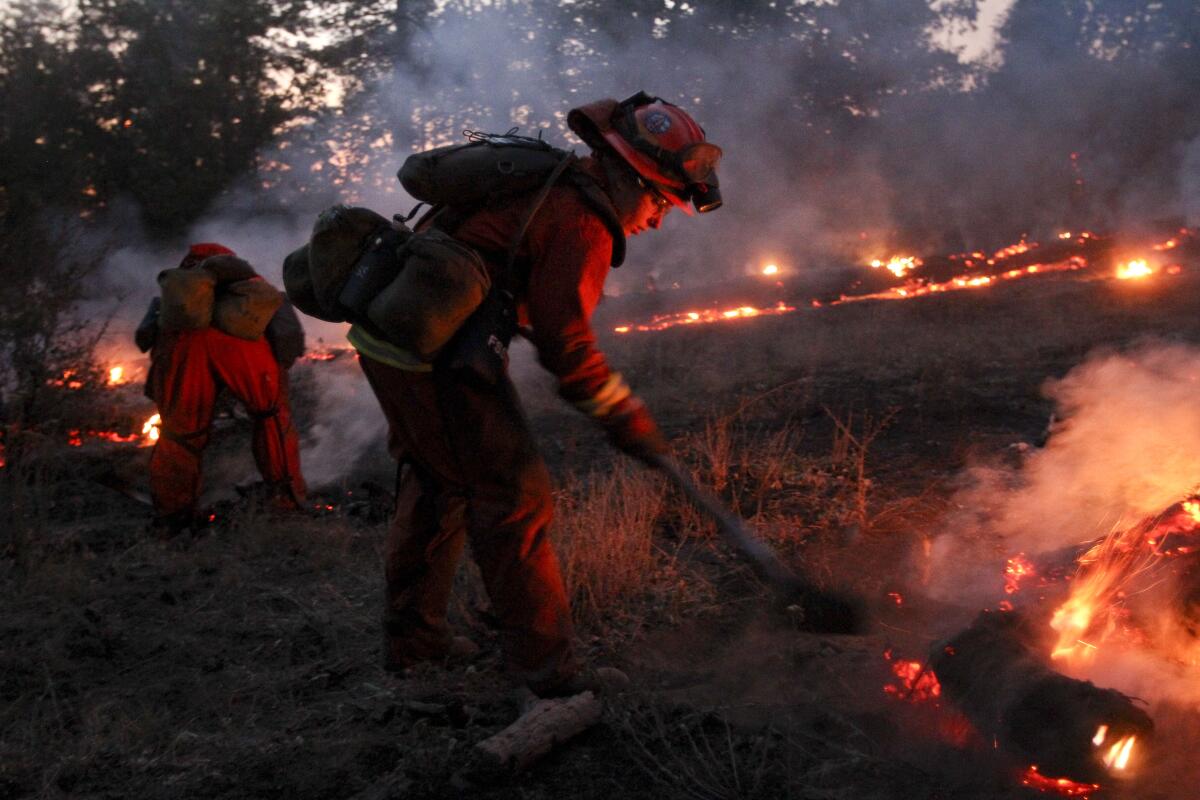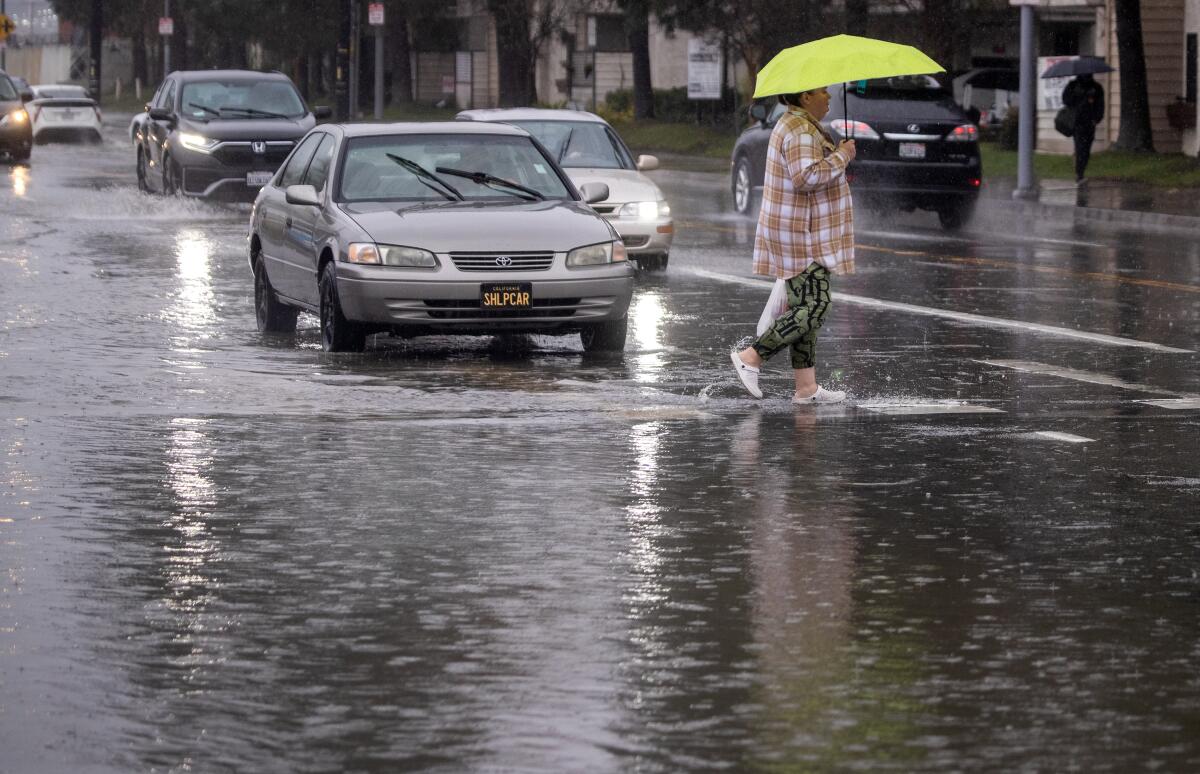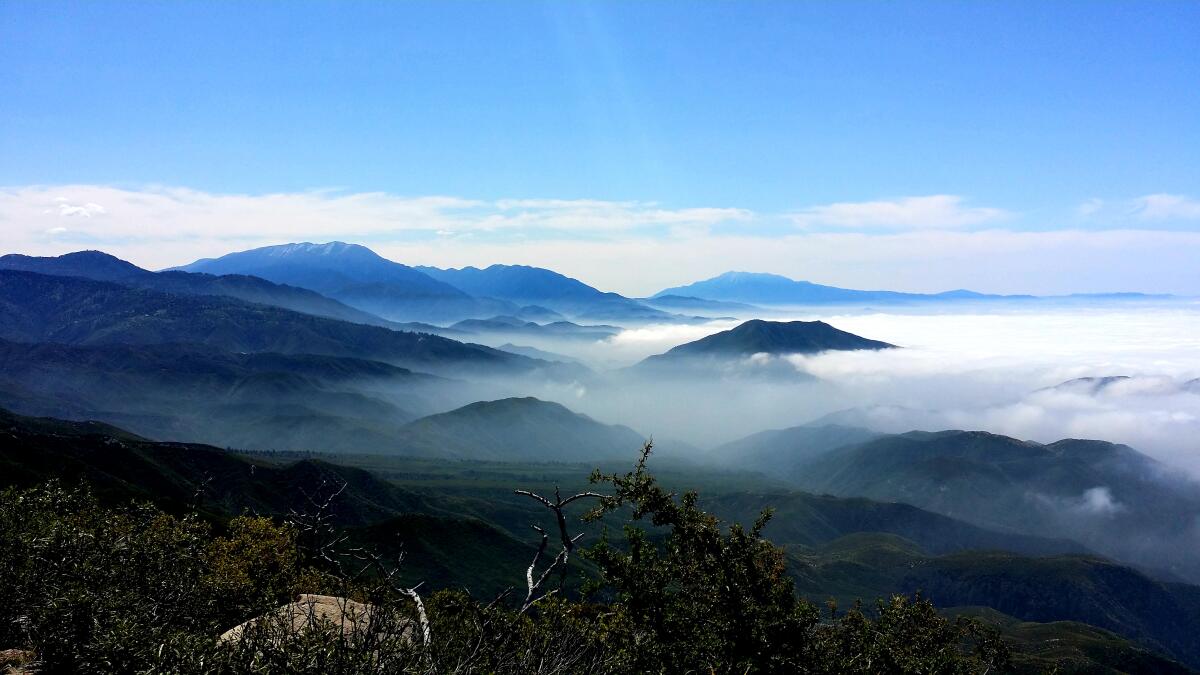A new push to ban involuntary servitude in California prisons

Good morning, and welcome to the Essential California newsletter. It’s Tuesday, Feb. 28.
Most of the the people incarcerated by the state of California are required to work while serving their prison sentences. The labor they do includes construction work, hospice care, computer coding and firefighting (joining fire crews is volunteer-based). They earn as little as 8 cents an hour and up to $20.44 per hour, “depending on the assignment and required skill level,” according to the California Department of Corrections and Rehabilitation.
That work can earn them time off their term and prison officials say the jobs help incarcerated people pay their restitution and other court-ordered fees.
But some California lawmakers and social justice advocates argue the current system represents a form of slavery. They’re backing Assembly Constitutional Amendment 8 — called the “End Slavery in California Act” — which would eliminate an exception clause in the state’s Constitution that “prohibits slavery and prohibits involuntary servitude, except as punishment to a crime.”
“This measure would instead prohibit slavery in any form, including forced labor compelled by the use or threat of physical or legal coercion,” the amendment, introduced by Assemblymember Lori D. Wilson (D-Suisun), states.
My colleague Hannah Wiley reports:
...advocates say the exception clause for prison labor has allowed states to exploit incarcerated people and continue slavery under a different name at the disproportionate expense of Black, Latino and Indigenous communities.
This isn’t the first attempt to change the rule. Last year, a proposal that would have put the issue to voters failed to get enough state Senate votes to get on the November ballot.
This year’s amendment wouldn’t bar incarcerated people from working, and it doesn’t set wages or dictate specific working conditions. But its supporters say the change could pave the way to give people in prison more freedom over the work they do.
Gov. Gavin Newsom voiced concern last year about the impact the change could have on the state’s budget should higher wages go into effect.
It’s been an “emotional debate,” Wiley writes, with “arguments that compared prison labor to slavery against concerns that eliminating work requirements would undermine rehabilitation and jeopardize restitution payments to crime victims.”
For Dorsey Nunn, executive director of Legal Services for Prisoners with Children and a formerly incarcerated person, the issue comes down to “a moral question.”
Nunn told Wiley about his work while incarcerated at San Quentin State Prison, where he handled chemicals to make detergent for California’s tunnels and highways. He said he was paid a little over $30 a month.
“Does slavery prepare me for the best opportunity to become an asset to the community as opposed to a liability?” he said. “What they’re doing is not necessarily leading to public safety at all.”
Prison officials maintain that the involuntary labor helps reduce recidivism. The California Prison Industry has about 7,000 incarcerated workers, making office furniture, clothing and food products, license plates and other goods. Officials there said participants in that program return to prison 26% to 38% less often.
Some state lawmakers opposed to the change argue that incarcerated people owe restitution to their victims and the change could have a negative impact on rehabilitative efforts.
If the proposal receives two-thirds support in both the state Assembly and Senate, it could go before voters in November 2024. But for now, as Wiley writes, “it’s unclear if the proposal would be more of a symbolic change than meaningful reform to California’s prisons.”
You can read Wiley’s full report here.
And now, here’s what’s happening across California:
Note: Some of the sites we link to may limit the number of stories you can access without subscribing.
L.A. STORIES
This weekend’s intense storms knocked out power for well over 100,000 L.A. County residents. With tens of thousands entering the week still without electricity, many question what’s taking local agencies so long. “They saw this coming,” one resident told my colleague Laura Newberry. “Can’t they go into overdrive a little bit?” Los Angeles Times

A Los Angeles family wants answers and accountability after a Black mother died in childbirth. The family of April Valentine is calling for investigations of the hospital where she died and her OB-GYN. Valentine’s death underscores an alarming statistic: In California, Black people die from pregnancy complications at a rate nearly four times higher than the general population. LAist
An off-the-radar teachers union election could have a big impact on the education of L.A. children. United Teachers Los Angeles will decide who wields power within its powerful union this week, setting the stage for what its 35,000-member union will prioritize during a critical time for students’ and schools’ pandemic recovery. Los Angeles Times
Check out "The Times" podcast for essential news and more
These days, waking up to current events can be, well, daunting. If you’re seeking a more balanced news diet, “The Times” podcast is for you. Gustavo Arellano, along with a diverse set of reporters from the award-winning L.A. Times newsroom, delivers the most interesting stories from the Los Angeles Times every Monday, Wednesday and Friday. Listen and subscribe wherever you get your podcasts.
POLITICS AND GOVERNMENT
California community colleges are relying too much on part-time faculty and misspending funds meant for full-time faculty. That’s according to a new report from California’s state auditor, who faults state chancellor’s office for not providing proper oversight. EdSource
A state bill introduced this month aims to put an all-gender restroom in all public schools. Several California school districts are already making that a reality for students. KQED
Can California’s public transit agencies hit the brakes in time to avoid a looming “fiscal cliff?” Many systems face falling ridership and funding cuts and are imploring state lawmakers to send them a lifeline. The Sacramento Bee
CRIME, COURTS AND POLICING
A Los Angeles woman who admitted to her role in a $18-million pandemic relief scam before fleeing the country is back in U.S. custody. Tamara Dadyan was extradited Monday from Montenegro over a year after she was sentenced to serve 10 years and 10 months in prison. Los Angeles Times
Hearst Castle became a crime scene Sunday after a man armed with a machete allegedly stole a utility company’s truck in Cambria and then fled from authorities, driving up to the fabled estate and barricading himself in a guest house. Visitors to the castle were told to shelter in place and the suspect was later arrested. San Luis Obispo Tribune
Support our journalism
HEALTH AND THE ENVIRONMENT
Facing a projected $22.5-billion deficit, Gov. Gavin Newsom said California can no longer contribute funding to centers providing COVID testing and vaccines for migrants. Now the centers are seeking federal funding to keep the resources available. San Francisco Chronicle
A $4.4-billion project to construct a new reservoir on the Sacramento River has been in the works for decades — and is still almost a decade away. Why is it taking so long to get the Sites Reservoir built? CalMatters
CALIFORNIA CULTURE
A historic L.A. movie lot is poised to get a $1-billion makeover. Radford Studio Center turns 95 this year and became known as “Hit City” for the popular TV shows that filmed there, including “Leave It to Beaver,” “Gilligan’s Island,” “The Mary Tyler Moore Show” and “Will & Grace.” The center’s owners have submitted plans to add up to 1 million square feet of new soundstages, production facilities and offices. Los Angeles Times
The legal fight over a Marilyn Monroe statue in Palm Springs continues after a state appeals court overturned the decision to dismiss a lawsuit against the city. Back in 2021, a group of residents sued Palm Springs, saying the city had no authority to close off a public street to display the 26-foot-tall statue, which has been a tourist draw on Museum Way in recent years. I guess some like it not. KESQ
Free online games
Get our free daily crossword puzzle, sudoku, word search and arcade games in our new game center at latimes.com/games.
AND FINALLY
Today’s California landmark comes from Paul Ventura from Laguna Hills:
The San Bernardino Mountains.

Paul writes:
In around two hours one can go from the Pacific Ocean to Lake Arrowhead and Big Bear and the beauty of the pristine forest and mountain air. The beauty of California is all around us, desert, mountains, ocean and redwoods.
What are California’s essential landmarks? Fill out this form to send us your photos of a special spot in California — natural or human-made. Tell us why it’s interesting and what makes it a symbol of life in the Golden State. Please be sure to include only photos taken directly by you. Your submission could be featured in a future edition of the newsletter.
Please let us know what we can do to make this newsletter more useful to you. Send comments to [email protected].
Sign up for Essential California
The most important California stories and recommendations in your inbox every morning.
You may occasionally receive promotional content from the Los Angeles Times.




